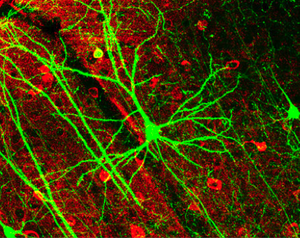Scientists have discovered that nerve cells passing toxic chemicals amongst themselves could cause the disease. A paper in PNAS this week by UCSD scientist Paula Desplats and her colleagues has shed new light on the pathological process than underlies thedegenerative brain condition Parkinson's Disease. Sufferers develop muscle tremors and experience progressive difficulty with initiating movements. Studies on Parkinson's brains have shown that victims lose a population of nerve cells that produce the transmitter chemical dopamine. But associated with this cell loss is the accumulation of a pathological protein called alpha-synuclein, which builds up inside affected cells, eventually destroying them.
 Scientists had expected this process to take a lifetime to occur but, intriguingly, when new dopamine-producing stem cells are injected into the brain to alleviate the disease these too quite quickly succumb to this destructive build up. But what causes this accumulation and how it is triggered in grafted nerve cells wasn't known...until now. In an elegant series of experiments the UCSD team showed that when healthy nerve cells are cultured alongside a second group of nerve cells making a labelled form ofalpha-synuclein, the healthy cells pick up the labelled protein from theirneighbours. "The same thing happens with stem cells, including when healthy stem cells are injected into the brain," explains Desplats.
Scientists had expected this process to take a lifetime to occur but, intriguingly, when new dopamine-producing stem cells are injected into the brain to alleviate the disease these too quite quickly succumb to this destructive build up. But what causes this accumulation and how it is triggered in grafted nerve cells wasn't known...until now. In an elegant series of experiments the UCSD team showed that when healthy nerve cells are cultured alongside a second group of nerve cells making a labelled form ofalpha-synuclein, the healthy cells pick up the labelled protein from theirneighbours. "The same thing happens with stem cells, including when healthy stem cells are injected into the brain," explains Desplats.
The alpha-synuclein, it seems, is exported from affected cells and imported into healthy cells by a process called endocytosis. Once inside the healthy cell the alpha-synuclein seeds the accumulation of a new aggregate, eventually compromising the cell. This discovery sheds new light on how Parkinson's disease may manifest and why, ultimately, the disease also beings to affect other brain circuits in addition to the dopamine-producing system. "Now that we have identified this process it could open up a new avenue to discover ways to stop this inter-cellular trafficking of this pathogenic protein," Desplats points out.
- Previous Put a shrimp in your tank
- Next Sticky tape and terahertz radiation










Comments
Add a comment